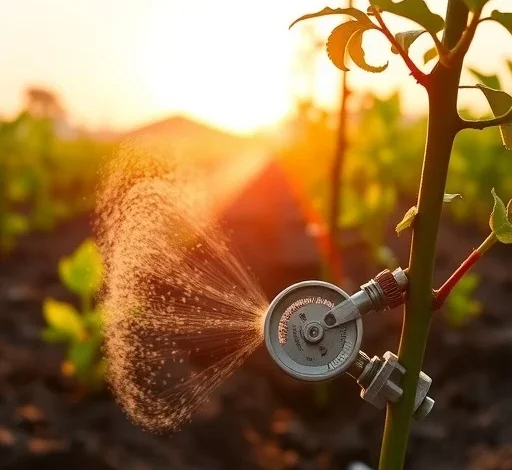Advancements in IoT-Driven Smart Drip Irrigation

The agricultural landscape of the 21st century is at a crucial tipping point, with smart technologies poised to revolutionize traditional farming practices. Drip irrigation, long heralded for its efficiency, is undergoing a significant transformation through the integration of Internet of Things (IoT) technologies. This novel approach intersects connectivity with agronomy, promising to enhance both yield and sustainability in various agricultural contexts. A fresh perspective introduced in an innovative review by Jaiswal, Kumar, and Shukla delves into the mechanics of smart drip irrigation systems that are increasingly becoming indispensable for future farming.
Smart drip irrigation systems utilize sensors and controllers governed by IoT to monitor and adjust water use in real time. By precisely measuring soil moisture levels, climate conditions, and plant water needs, these systems are tailored to optimize water application. This method of irrigation not only lowers water waste but also improves crop health by ensuring that plants receive exactly what they need, when they need it. This efficiency has placed smart systems at the forefront of sustainable agricultural practices and warrants a deeper exploration of their architectures, machine learning applications, and emerging trends in the field.
At the heart of these smart systems lies an array of sophisticated sensors. Soil moisture sensors, for instance, deliver critical data on the water content in the root zone, allowing for timely irrigation. This data is complemented by climatic sensors that provide information regarding temperature, humidity, and precipitation forecasts, creating a holistic view of the environmental conditions. By leveraging this sensor-driven data, farmers can make informed, data-driven irrigation decisions that align water usage with crop requirements, ultimately maximizing efficiency and yield.
Machine learning models play a pivotal role in interpreting the data gathered from these sensors. Algorithms can analyze historical data, recognize patterns, and predict future requirements based on current environmental conditions and crop growth stages. For instance, a machine learning model could determine the optimal irrigation timing and quantity by learning from past irrigation events and their outcomes. The result is a dynamic irrigation schedule that evolves with changing weather patterns and crop needs, leading to significantly enhanced resource management.
Moreover, the architecture of smart drip irrigation systems is an intricate blend of hardware and software components designed for seamless integration. This may involve the deployment of edge computing, where data is processed locally, thereby speeding up response times and minimizing the load on central servers. Such architecture enables real-time monitoring and decision-making, crucial for adjusting irrigation schedules instantly based on emerging weather conditions or sensor input. These technological advancements underscore the shift towards more autonomous agricultural practices, where farmers are increasingly supported by intelligent systems, rather than relying solely on human judgment.
The opportunities presented by IoT in agriculture extend beyond just improved irrigation efficiency. As these smart systems gather vast amounts of data, they can also provide insights into overall farm management. This includes crop health monitoring, nutrient management, and pest detection, creating a comprehensive agricultural ecosystem where each component works synergistically. The interconnectedness facilitated by IoT enables farmers to manage their practices holistically, ensuring that each decision made contributes positively to the overall output and sustainability of their operations.
However, despite the promising capabilities of smart drip irrigation systems, challenges remain. The initial investment cost for these technologies can be substantial, which may deter some farmers, particularly in developing regions. Furthermore, the adoption of these systems requires a certain level of technological proficiency and access to reliable network connectivity, which can further complicate deployment in remote areas. Bridging these gaps by enabling access to technology and providing adequate training for farmers is essential to fully realize the benefits of smart irrigation systems.
Public awareness and education around the potential of smart irrigation systems are pivotal for their widespread acceptance and implementation. Engaging in community workshops, partnerships with agricultural universities, and providing case studies of successful implementations could inspire farmers to embrace these technologies. Highlighting not just the efficiency but also the environmental benefits—such as reduced water use and lower energy requirements—can resonate deeply within the farming community, ultimately cultivating a culture of sustainable innovation.
As the research by Jaiswal, Kumar, and Shukla illustrates, the future of smart irrigation is closely tied to ongoing advancements in IoT and machine learning. The coming years will likely witness a further integration of artificial intelligence to create more sophisticated models that can predict not only irrigation needs but also the potential impacts of climate change on agricultural productivity. This evolution points towards a future where farmers are not just reactive but proactive in managing their resources.
In summary, embracing smart drip irrigation systems equipped with IoT capabilities stands as a crucial step forward in the quest for sustainable agriculture. The potential to refine water usage, enhance crop productivity, and respond proactively to environmental challenges positions these technologies at the forefront of modern farming. As the discourse around smart agriculture continues to evolve, it will serve to not only improve the livelihoods of farmers but also contribute positively to global environmental sustainability.
As this transformation gains momentum, it is imperative to foster dialogue between farmers, technology developers, and policy-makers. Collaborative initiatives can facilitate research and development to drive down costs, improve user-friendliness, and broaden access to technology, ensuring that the benefits of smart drip irrigation systems can be enjoyed by all. Only through collective efforts can the agricultural community harness the potential of these innovations to secure a sustainable food future.
The integration of IoT into agriculture is more than just a trend; it is a revolutionary shift that could reshape how we approach farming in an era defined by climate change and resource scarcity. By adopting these smart techniques, the agricultural sector can aspire to not only maintain but enhance productivity in the face of declining natural resources. The collaborative efforts of researchers, farmers, and technology developers will undoubtedly shape the path forward, transforming challenges into opportunities for a sustainable agricultural revolution.
Subject of Research: Smart Drip Irrigation Systems Using IoT
Article Title: Smart drip irrigation systems using IoT: a review of architectures, machine learning models, and emerging trends.
Article References:
Jaiswal, N., Kumar, T.V. & Shukla, C. Smart drip irrigation systems using IoT: a review of architectures, machine learning models, and emerging trends.
Discov Agric 3, 253 (2025). https://doi.org/10.1007/s44279-025-00430-1
Image Credits: AI Generated
DOI: https://doi.org/10.1007/s44279-025-00430-1
Keywords: Smart irrigation, IoT, Drip irrigation, Machine learning, Sustainable agriculture.
Tags: advancements in agricultural technologyenhancing crop yield through technologyfuture trends in smart agricultureintegrating IoT with agronomyIoT-driven smart drip irrigationmachine learning in agricultureoptimizing water usage in farmingprecision agriculture with sensorsreal-time water management systemsreducing water waste in farmingsmart irrigation system architecturessustainable farming practices





